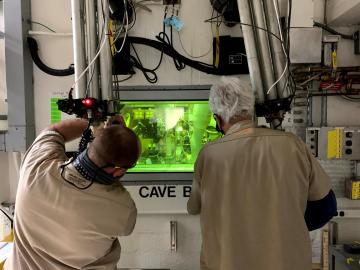
Filter News
Area of Research
- Advanced Manufacturing (1)
- Biology and Environment (48)
- Biology and Soft Matter (1)
- Computer Science (2)
- Energy Frontier Research Centers (1)
- Energy Science (35)
- Fusion and Fission (4)
- Isotope Development and Production (1)
- Isotopes (24)
- Materials (58)
- Materials for Computing (12)
- National Security (21)
- Neutron Science (17)
- Nuclear Science and Technology (5)
- Quantum information Science (5)
- Supercomputing (72)
News Type
News Topics
- (-) Biotechnology (36)
- (-) Cybersecurity (31)
- (-) Frontier (61)
- (-) Isotopes (55)
- (-) Nanotechnology (50)
- (-) Polymers (25)
- (-) Quantum Science (80)
- (-) Space Exploration (16)
- 3-D Printing/Advanced Manufacturing (109)
- Advanced Reactors (25)
- Artificial Intelligence (114)
- Big Data (58)
- Bioenergy (95)
- Biology (108)
- Biomedical (61)
- Buildings (50)
- Chemical Sciences (72)
- Clean Water (19)
- Composites (24)
- Computer Science (180)
- Coronavirus (37)
- Critical Materials (17)
- Education (5)
- Element Discovery (1)
- Emergency (3)
- Energy Storage (80)
- Environment (162)
- Exascale Computing (64)
- Fossil Energy (7)
- Fusion (57)
- Grid (50)
- High-Performance Computing (114)
- Hydropower (6)
- ITER (6)
- Machine Learning (53)
- Materials (113)
- Materials Science (120)
- Mathematics (9)
- Mercury (9)
- Microelectronics (4)
- Microscopy (44)
- Molten Salt (5)
- National Security (81)
- Neutron Science (139)
- Nuclear Energy (99)
- Partnerships (67)
- Physics (65)
- Quantum Computing (48)
- Security (30)
- Simulation (54)
- Software (1)
- Statistics (3)
- Summit (62)
- Transportation (61)
Media Contacts

Through a consortium of Department of Energy national laboratories, ORNL scientists are applying their expertise to provide solutions that enable the commercialization of emission-free hydrogen fuel cell technology for heavy-duty

The U.S. Department of Energy’s Innovative and Novel Computational Impact on Theory and Experiment, or INCITE, program is seeking proposals for high-impact, computationally intensive research campaigns in a broad array of science, engineering and computer science domains.

When COVID-19 was declared a pandemic in March 2020, Oak Ridge National Laboratory’s Parans Paranthaman suddenly found himself working from home like millions of others.

Using complementary computing calculations and neutron scattering techniques, researchers from the Department of Energy’s Oak Ridge and Lawrence Berkeley national laboratories and the University of California, Berkeley, discovered the existence of an elusive type of spin dynamics in a quantum mechanical system.

A rare isotope in high demand for treating cancer is now more available to pharmaceutical companies developing and testing new drugs.

Oak Ridge National Laboratory was among an international team, led by Lawrence Livermore National Laboratory, who synthesized 108 elevated carbon dioxide, or CO2, experiments performed in various ecosystems to find out how much carbon is

A new method developed at Oak Ridge National Laboratory proves one effort’s trash is another’s valuable isotope. One of the byproducts of the lab’s national plutonium-238 production program is promethium-147, a rare isotope used in nuclear batteries and to measure the thickness of materials.

Researchers at the Department of Energy’s Oak Ridge National Laboratory and the University of Tennessee are automating the search for new materials to advance solar energy technologies.

A team of researchers at Oak Ridge National Laboratory and Purdue University has taken an important step toward this goal by harnessing the frequency, or color, of light. Such capabilities could contribute to more practical and large-scale quantum networks exponentially more powerful and secure than the classical networks we have today.

Balendra Sutharshan, deputy associate laboratory director for operational systems at DOE’s Pacific Northwest National Laboratory, has joined ORNL as associate laboratory director for the Isotope Science and Engineering Directorate.


